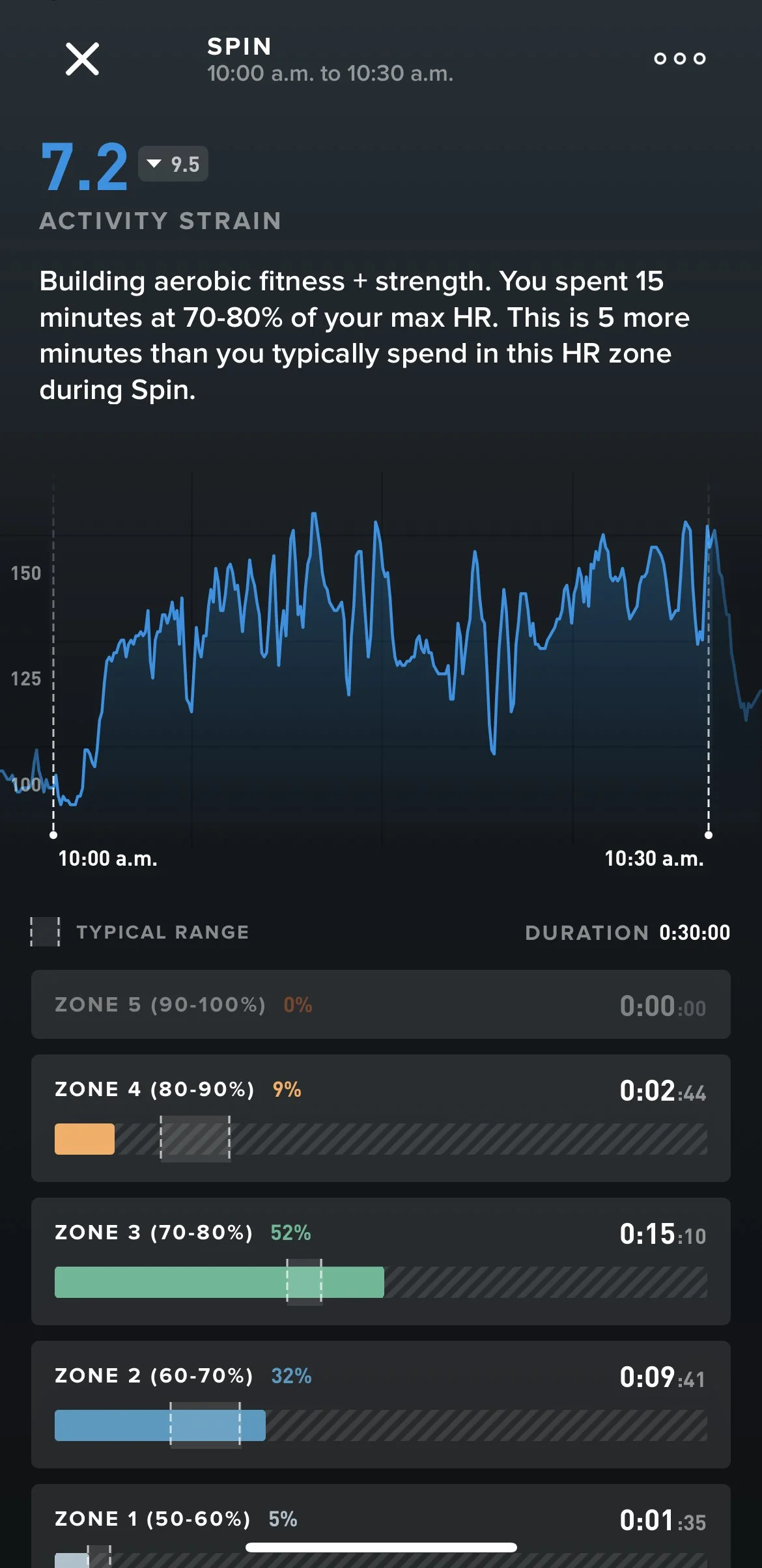TRAINING DURING PREGNANCY: WHAT THE TEXTBOOKS NEVER SAID
MY RESISTANCE TRAINING & PREGNANCY EXPERIENCE
For me, my third trimester body perceives more “exercise stress” right now by vacuuming and making dinner than it does lifting 3 sets of 10 bench press at 80% RPE (based on my Whoop fitness tracking wearable). My heart rate sometimes gets higher than 150bpm cleaning my home than it does on the bike in the gym. Yet, I still get shocked looks when I set down the barbell or unsolicited lectures on “dialling back” in the gym.
It seems to be more acceptable for me as a pregnant woman to vacuum than it is to lift weights at the gym, but the truth is resistance training can be 100% safe throughout all trimesters of pregnancy. Consider second, third and fourth time mom’s of young kids that are hauling around heavy car seats and diaper bags while pregnant with their next bundle? Or expecting women who are also expected to work their full time physical jobs throughout pregnancy like those in trades, nurses, coaches and physiotherapists, etc. These women are lifting and active and are completely capable of and expected to be handling the lifting and loading while pregnant.
Below is my activity report for 30 minutes on a spin bike vs. 60 minutes of chores around the house. It’s almost the exact same heart rate statistics, which highlights the importance of training for your individual body rather than black and white rules of “good” vs. “bad” movement.
This makes the restrictive and dated beliefs of don’t lift over 20 pounds or get your heart rate above 150bpm laughable. Although, these are not the current training recommendations there is still a lot of belief and emphasis towards them. Data collection shows that although almost all health care providers agree that exercise is beneficial during pregnancy, but 64% of health care providers still believe these unfound claims to be true! (Bauer et. al, 2010).
The above vacuum vs. spin bike heart rate comparison is also a clear and important reminder that a body’s capabilities are highly individual and it’s about finding the right amount of intensity for you. It’s also clear to me that guidelines should not be hard rules with no flexibility.
I am writing this piece, not to brag about my appearingly “easy” pregnancy and training schedule, but rather shed light on the fact that training during pregnancy should be highly individual based on the person, the pregnancy, and the day. It highlights the need for more data and education on resistance training pre and post partum and the positive associated benefits and resiliency it can create for an expecting body.
Ice Physiotherapy Certified: Pre/Post Natal Fitness & Rehab, 2023
BENEFITS OF RESISTANCE TRAINING DURING PREGNANCY
Staying active during pregnancy is not only safe, but also highly beneficial for both the mother and the developing fetus. The Canadian physical activity guidelines suggest that pregnant individuals should engage in at least 150 minutes of moderate-intensity aerobic activity spread throughout the week. It is important to note that if a pregnant person was previously inactive, they should gradually increase their activity level. Strength training exercises are also highly encouraged during pregnancy, focusing on major muscle groups. These activities help to improve cardiovascular fitness, maintain a healthy weight, and reduce the risk of developing gestational diabetes and hypertension.
Although, this is great news that the guidelines state we don’t need to change much, it’s not exactly helpful when so much is changing.
It’s important to remember that all bodies and pregnancies are different and can vary even day to day. What works for me, may not be what’s best for you. I hope that in the following blog we can go beyond the basic recommendation of 150 minutes of moderate-intensity activity. I hope to highlight the importance of individualized training, working with your changing body, let you in on my training program tips, and help empower you to make the best choices for you and your growing bump. The more we share our experiences the more we can normalize all types of pregnancies, bodies and methods to approaching 40 weeks of change.
Need assistance and accountability sorting through it all? Apply for personal training with a pre/post natal certified coach here.
TRAINING RED FLAGS & CONTRADICTIONS
Although resistance training during pregnancy is part of the recommended Canadian Guidelines for Physical Activity, it’s important to keep an eye out for training red, yellow and blue lights and contradictions that may interrupt regular resistance training. These lights may restrict training or require modification by a personal trainer.
MY INDIVIDUAL PREGNANCY
When I first found out I was pregnant, there was a mourning period. Although we are of course happy and blessed to be able to have children (and wanted to grow our family), there was still a part of me that was mourning the loss of everything in my life that came before this. My whole life I have identified as an elite athlete turned fitness professional. The majority of my 30 years on earth has revolved around my body, it’s performance levels, and my health and fitness. The first three months of pregnancy I was learning to accept change and I remained in shock and denial for a long time. I was trying to accept this new chapter of my story without burning all the chapters that came previously.
All my courses and textbooks told me that I could continue training, BUT it was about to drastically change. Add it to the list of changes I would need to accept over the next 40 weeks and beyond. Yet, here I am writing this at 32 weeks in shock and awe of how my training didn’t quite fit “the resistance training during pregnancy plan”. I share this in hopes that it can inspire other expecting women to continue their training with a highly individualized approach based on your body and your own pregnancy. You’re more resilient and capable than you may believe.
FIRST TRIMESTER
Ball hockey @ 21 weeks
I have additionally been blessed with a non-complicated pregnancy so far. I felt great my entire first trimester aside from the first 30 days where I couldn’t seem to recover or get enough sleep. I topped it off to being “burnt out” from January, a busy month for a gym owner. A positive pregnancy test in late January presented an alternative reason for that tiredness. After that, I felt mostly good although my love for caffeine subsided and weirdly enough my ears felt like they were underwater for the next 3 months. However, I’d take the temporary loss of clear hearing over extreme nausea any day. I realize that so many women suffer through first trimester illness and fatigue, so I consider myself very fortunate and recognize the privilege this gave me to continue with my training in the gym.
My training in the first trimester did not change. I continued to lift, participate in Jolt classes, use my spin bike, walk my dog, and play ball hockey and Pickleball. The goal was to continue these activities for as long as possible, not only for the physical health benefits, but the mental health benefits too. I knew I would need to continue with my activities to keep a level head as I prepared for a long eight months ahead of me.
What my textbooks said about the first trimester:
It had previously been thought that training during the first trimester increased the risk for miscarriage. This is a proven MYTH. Now exercise during first trimester is encouraged for all pregnancies as long as there are no red lights present. Training during the first trimester sounds simple right? Yet, extreme fatigue and nausea for many women says otherwise. Typically as personal trainers we’re advised to reduce training load for our clients in the first trimester due to extreme fatigue and nausea. When a body is sick and tired, there’s not much spare energy for performance in the gym. Additionally, the body lacks the fundamental requirements (sleep and nutrients) to build muscle and resiliency. Training through lack of sleep, extreme fatigue, and nutrient/hydration deficiencies increases the risk for injury and muscle loss. If you’re experiencing nausea and fatigue in your first trimester, you may not be able to continue training as you had previously. Your training may need to take a day to day approach depending on your needs. A personal trainer can help modify exercises and intensity to meet you where you’re at if you spent a few hours on the bathroom floor earlier. A trainer will help optimize areas like stress management, sleep requirements, nutrition and workouts to help you feel your best in the bouts between morning sickness. If you’re fortunate like I was then it’s business as usual as long as there are no other training red lights.
SECOND TRIMESTER
Biking NYC in my second trimester
I was shocked by my body’s ability to continue these activities well into my second trimester. I expected myself to become fragile, weak and exhausted by training. This is the perception that society also places on expecting women. Rather I was empowered by my resiliency and energized by my strength. Although as I progressed, I dialled back the overall intensity, I still felt great and strong in the majority of my lifts. I was able to use this time to prioritize training my glutes, core and upperback for a strong and resilient pregnant body. All pre/postnatal certifications warn of the training modifications that we need to make early in pregnancy and media often portrays pregnant women as fragile and ill. I figured that by the second trimester I would no longer be able to perform pull-ups, deadlifts and sit-ups. However, I was able to continue some of these lifts right into my third trimester (and hopefully some right up until the last week!).
This is an important reminder to listen to our bodies. If you feel good, push it! If you feel weak, dial back. Don’t let narratives or society’s expectations determine your individual training intensity.
What my textbooks said about the second trimester:
We are taught that the second trimester is a great time to push the intensity. We consider modifications based around a growing bump that may interfere with bar path, a decrease in core stability, the weight of baby on the pelvic floor, and removing Valsalva Maneuvers (advanced breath work that increases intra abdominal pressure). However my experience was the opposite. I dialled back intensity in comparison to the first trimester and felt more fatigue in the second trimester. The second trimester we’re taught to modify movements based on balance/centre of gravity, internal pressure management, and a growing bump that limits range of motion. For example, opting for a sumo stance deadlift instead of a conventional deadlift, eliminating pull-ups and sit-ups for pressure management, and keeping two feet on the floor for balance control. I would argue that these modifications aren’t inherent to the second trimester, but rather the individual body and pregnancy. Everyone has different strengths, fitness levels prior to birth, and bodies during pregnancy to explicitly limit exercises based on trimester rather than the individual seems short sighted.
THIRD TRIMESTER:
Third trimester deadlifts
I am just a few LONG weeks into the third trimester while I write this. The fatigue in daily tasks is catching up to me which is visibly heard in my Darth Vadar breathing and dramatic exhales that could cause a Tsunami around the world. The shortness of breath, tired ankles, and ligament pressure has me feeling like a stale pretzel some days. I have increased my frequency of deep breathing and meditation drills to almost daily, I am incorporating more hip mobility, and trying to increase my sleep as much as possible. Yet despite the fatigue creeping in, I still feel pretty great in the gym when I am resistance training. It may seem hard to believe, but switching sides at night with my pregnancy pillow seems like more of a workout than deadlifts and deadbugs. Additionally, walking feels like more pressure on my pelvic floor than a squat or overhead press. I chalk this up to the fact that in the gym you have 100% control over your lifting technique and intensity to ensure that your lifts feel good. In the real world, tasks can be awkward and intensity can’t be modified by swapping out a few plates and dumbbells. I have eliminated pull-ups, jumping and high intensity cardio. I have continued to focus on glute, core and upper back strength.
What my textbooks said about the third trimester:
Most of the third trimester training is typically focused on deep breathing, relaxing the pelvic floor and hip mobility. This is a quick growth phase for our body where a woman gains on average 1/2 pound per week. Most exercise modifications are made in trimester 2 where as trimester 3 we modify intensity and range of motion.
There are a few exercises that have surprised me that I am shocked none of my courses had considered mentioning for modifications:
1) The conventional barbell deadlift: I expected this lift to be ruled out well before 32 weeks due to core instability and overall intensity. However, at 30 weeks I lifted the heaviest I had since pre-pregnancy and it felt great! A consideration crossed my mind that had never been mentioned in any of my courses - the additional weight I am carrying is also additional leverage against a 165 pound barbell. The heavier you are, typically the more weight you can deadlift due to bar leverage. As my baby grows bigger, my deadlift gets stronger. I will take that as a win, thanks baby! There’s an important caveat that goes along with this consideration: I am still able to manage internal pressure and core stability. This mean’s I am able to feel fully supported without abdominal doming, incontinence or back pain during this movement. This isn’t going to be the case for everyone, so while the additional leverage may be beneficial for some people for a few short weeks it may posses a training risk for others who do not have the internal pressure management and stability.
2) Split stance squats and calf raises: The additional weight on my body benefited my deadlift, but in a split stance position (whether I am holding Warrior pose at Yoga or performing split squats at Lift) the additional weight feels like a brick house sitting on 90’s air chair ankles. I feel weaker than a goat on ice in split squats and calf raises and will be ruling them out of training from this point on. A consideration that never crossed my mind until I dropped an “holy F bomb” in the middle of a quiet yoga class.
FOURTH TRIMESTER:
The upcoming fourth trimester will be the biggest challenge and change for me yet. To be quite candid, I am dreading the recovery that comes after birth. As I mentioned at the beginning of this blog, my body’s strength and appearance has been the centre to my accomplishments and career for the majority of my life. Mentally, the last 32 weeks has not been easy watching my body change. However, I am inspired by the mindset growth I have had as I progress each trimester. I feel further encouraged by other’s around me who have participated in my Post Natal Program’s and of course Jolt’s other Pre/Post Natal Certified Coach, Bri. I look forward to sharing more about the fourth trimester, my training and recovery journey, and implementing that experience in addition to my textbook knowledge on all future Jolt Post Natal Programs and content.
My journey
I hesitated sharing my story as not to discourage or upset the people who have had awful symptoms of fatigue and illness throughout their pregnancy or been limited by the training “red lights”. I also realize that resistance training during pregnancy may not be a priority for everyone. However, I think it’s important to add positive stories, encouragement and experiences to the conversation to empower women to continue training in the best ways for their individual body throughout pregnancy. I think I would have been a lot less “scared” of my changing body and upcoming fitness routine, if I had heard more positive experiences and seen more women working with the current resistance training research. You may not have to sacrifice as much as you dread if you’re an athlete, love the gym, and have a performance based mindset. I think it’s important to focus on what we can do (individually) rather than where we may be limited. Pregnancy does not make us delicate, it only highlights the resiliency and strength that our bodies truly have.
I have worked with many women in the gym throughout their pregnancies and I have never ran the same pregnancy program twice. Each experience is unique with different challenges and strengths. It’s important to highlight not training for trimesters, but training based on your recovery, nutrition and energy levels on a day to day basis. A personal trainer can help adapt the right customized program for you throughout your pregnancy and support you both mentally and physically as you progress through all the changes. Apply for personal training here.
References:
Rowan, S.P., Lilly, C.L., Claydon, E.A. et al. Monitoring one heart to help two: heart rate variability and resting heart rate using wearable technology in active women across the perinatal period. BMC Pregnancy Childbirth 22, 887 (2022). https://doi.org/10.1186/s12884-022-05183-z
Prevett C, Kimber ML, Forner L, de Vivo M, Davenport MH. Impact of heavy resistance training on pregnancy and postpartum health outcomes. Int Urogynecol J. 2023 Feb;34(2):405-411. doi: 10.1007/s00192-022-05393-1. Epub 2022 Nov 4. PMID: 36331580.
Bauer PW, Broman CL, Pivarnik JM. Exercise and pregnancy knowledge among healthcare providers. J Womens Health (Larchmt). 2010 Feb;19(2):335-41. doi: 10.1089/jwh.2008.1295. PMID: 20113144.











